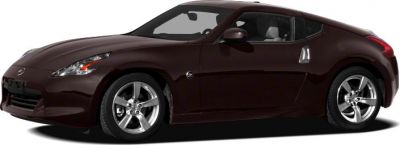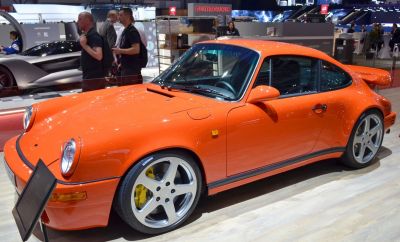 1987 Porsche 959 Dimensions, Size & Specs
1987 Porsche 959 Dimensions, Size & SpecsMeasurements of the 1987 Porsche 959, engineered for optimal performance and comfort
| Dimensions | |
|---|---|
| Length: | 4260 mm167.7 in14.0 ft |
| Width: | 1840 mm72.4 in6.0 ft |
| Height: | 1280 mm50.4 in4.2 ft |
| Ground Clearance: | 120 mm4.7 in0.4 ft |
| Weight Specifications | |
| Curb Weight: | 1450 kg3197 lbs |
| Maximal permitted Weight: | 1940 kg4277 lbs |
| Tire Specifications | |
| Rims Sizes: | 17-inch rims:
|
| Tire Sizes: |
|
The Porsche 959, produced between 1987 and 1988, stands as a remarkable classic sports coupe that showcased pioneering automotive technology and design during its era. With a length of 4260 mm (167.7 inches), width of 1840 mm (72.4 inches), and a low profile height of only 1280 mm (50.4 inches), the 959 was designed for aerodynamic efficiency and high-speed stability. The vehicle's curb weight is 1450 kg (3,197 lbs), striking a balance between structural rigidity and lightweight engineering, while its maximum permissible weight reaches 1940 kg (4,280 lbs), accommodating passengers and cargo. Ground clearance is kept minimal at 120 mm (4.7 inches), aligning with sports car requirements to lower the center of gravity and enhance handling. The 959 rides on advanced 17-inch rims in various sizes—9J x 17, 10J x 17, and 8J x 17—which are paired with high-performance tires measuring 235/45 R17, 255/40 R17, and 215/50 R17, contributing to excellent grip and road contact. This iconic Porsche coupe's dimensions and engineering details make it a significant point of reference in car size comparisons, especially among high-performance vehicles of its time. The Porsche 959 remains a symbol of innovation, combining compact yet aggressive styling with advanced technology, and continues to impress car enthusiasts with its blend of size, precision, and performance.
Discover the standout features that make the 1987 Porsche 959 a leader in its class
Have a question? Please check our knowledgebase first.
The Porsche 959 coupe, produced from 1987 to 1988, has a length of 4260 mm (167.7 inches), a width of 1840 mm (72.4 inches), and a height of 1280 mm (50.4 inches). These dimensions contribute to its low-slung, aerodynamic profile which was ahead of its time in the supercar segment. Its relatively wide stance and compact length support both stability and agility, making it a distinctly sized vehicle in the sports coupe category.
The curb weight of the Porsche 959 is approximately 1450 kg (3,197 lbs), which reflects the car with all standard equipment and fluids, ready to drive without passengers or cargo. Its maximum weight, which includes occupants and cargo, is rated at 1940 kg (4,278 lbs). The relatively lightweight design is due to advanced materials and engineering for its time, contributing to the car's impressive performance and handling characteristics.
The ride height of the Porsche 959 is 120 mm (4.7 inches), which is quite low compared to typical passenger cars. This low ground clearance helps lower the center of gravity of the vehicle, improving high-speed cornering and overall handling stability. However, it also means the car requires careful driving over uneven surfaces or speed bumps, as the chassis is close to the ground.
The Porsche 959 is equipped with a mix of rim sizes: 9J x 17 inches, 10J x 17 inches, and 8J x 17 inches. Its tires come in sizes 235/45 R17, 255/40 R17, and 215/50 R17. These large 17-inch rims with performance-oriented tires provide a wider contact patch with the road, enhancing grip for better cornering, acceleration, and braking. The variety in rim and tire sizes was designed to optimize traction and balance on both the front and rear axles.
With its length of 4260 mm (167.7 inches), width of 1840 mm (72.4 inches), and height of 1280 mm (50.4 inches), the Porsche 959 is compact enough to fit into most standard residential garages. The average garage door opening in many countries is about 2400 mm (94.5 inches) wide and roughly 2030-2130 mm (80-84 inches) tall, so the car's dimensions provide sufficient clearance width-wise and height-wise. However, care should be taken when parking due to its low ground clearance and wide stance.
The Porsche 959 is a unique model that did not have a direct predecessor with the exact same concept and full technological sophistication, as it was a technological showcase and an advanced supercar for its time. However, compared to the Porsche 911 models of the 1980s, which preceded it, the 959 is slightly larger in width and has a lower height, emphasizing its aerodynamic and performance-driven design. The 959 is also heavier than standard 911s due to advanced but weighty components such as its all-wheel-drive system and turbocharged engine, tipping the scales at about 1450 kg compared to lighter 911 variations.
During the late 1980s, the Porsche 959 stood out among supercars thanks to its combination of compact yet wide dimensions and cutting-edge technology. Compared to contemporaries like the Ferrari F40 (length: 4380 mm, width: 1970 mm) and the Lamborghini Countach (length: ~4485 mm, width: ~2000 mm), the 959 was slightly smaller in length and notably narrower, giving it a nimble and balanced feel. Despite its smaller size, the 959 incorporated advanced technologies including full-time all-wheel drive, twin-turbocharged engines, and sophisticated suspension that put it ahead in terms of handling and performance capabilities.
The Porsche 959 is a two-seater coupe designed with a focus on driver and passenger ergonomics and performance-oriented driving experience. Its interior space is compact and intimate, emphasizing the sportscar ethos. Given its external dimensions, the cabin is designed to comfortably fit two adults with enough room for driving control and comfort, but minimal rear or additional passenger space. The focus was on creating a lightweight and driver-centric environment rather than maximizing interior volume.
When introduced in 1987, the Porsche 959 was one of the most technologically advanced sports cars in the world. It featured a 2.85-liter twin-turbocharged flat-six engine producing around 450 horsepower. Its innovation included an advanced all-wheel-drive system that improved traction in all conditions, a lightweight but strong composite body, and adjustable suspension systems. These features, combined with aerodynamic design and advanced tires, gave the 959 exceptional acceleration, top speed (over 317 km/h or 197 mph), and handling that set new standards in the automotive world.
The Porsche 959's weight distribution is carefully balanced to enhance driving dynamics, typically close to the ideal 50:50 front-to-rear ratio, thanks to its mid-rear engine placement and all-wheel-drive configuration. The chassis design incorporates lightweight materials and a robust yet flexible frame to support high speeds and aggressive cornering. This balance in weight, combined with advanced suspension geometry and all-wheel traction, results in supreme stability, responsive steering, and excellent grip, making the 959 one of the best-handling supercars of its era.
Discover similar sized cars.

| Production: | 2008-2012 |
|---|---|
| Model Year: | 2009 |
| Length: | 4250 mm167.3 in |
| Width: | 1845 mm72.6 in |
| Height: | 1310 mm51.6 in |

| Production: | 2018-present |
|---|---|
| Model Year: | 2018 |
| Length: | 4207 mm165.6 in |
| Width: | 1819 mm71.6 in |
| Height: | 1265 mm49.8 in |
